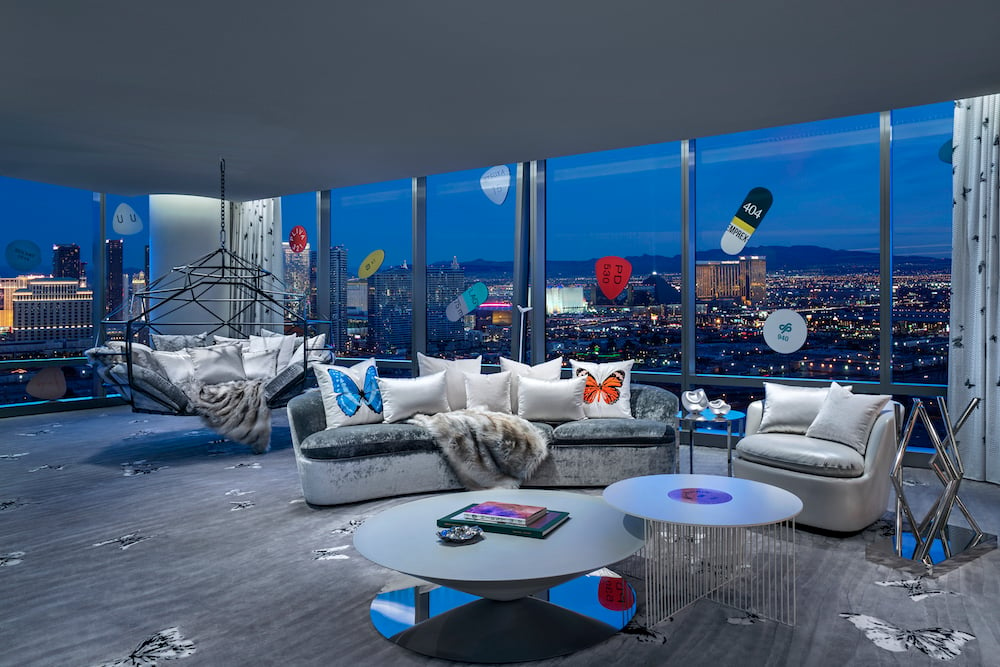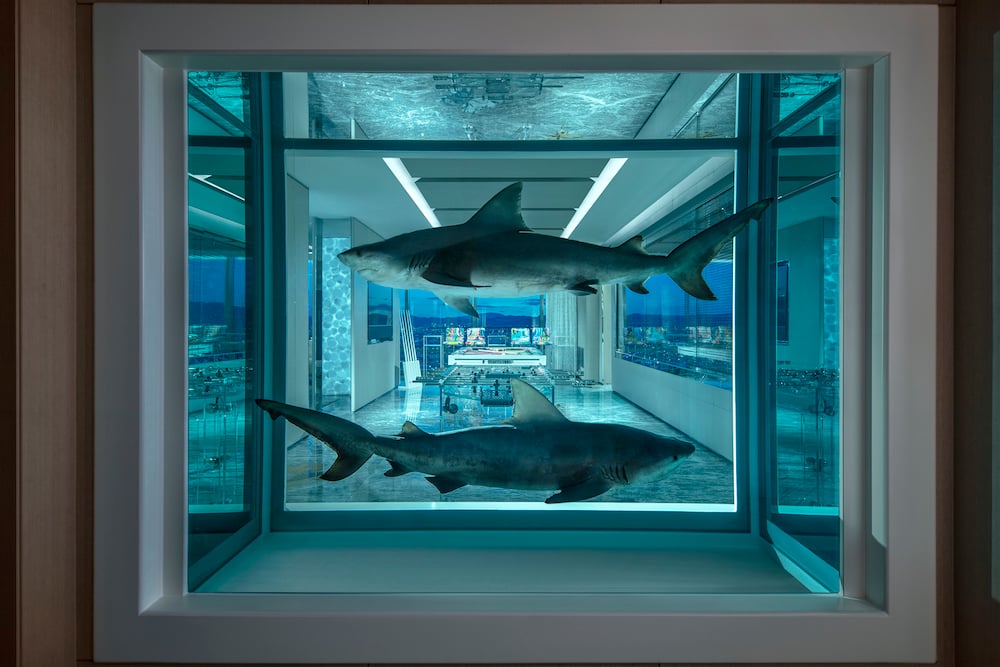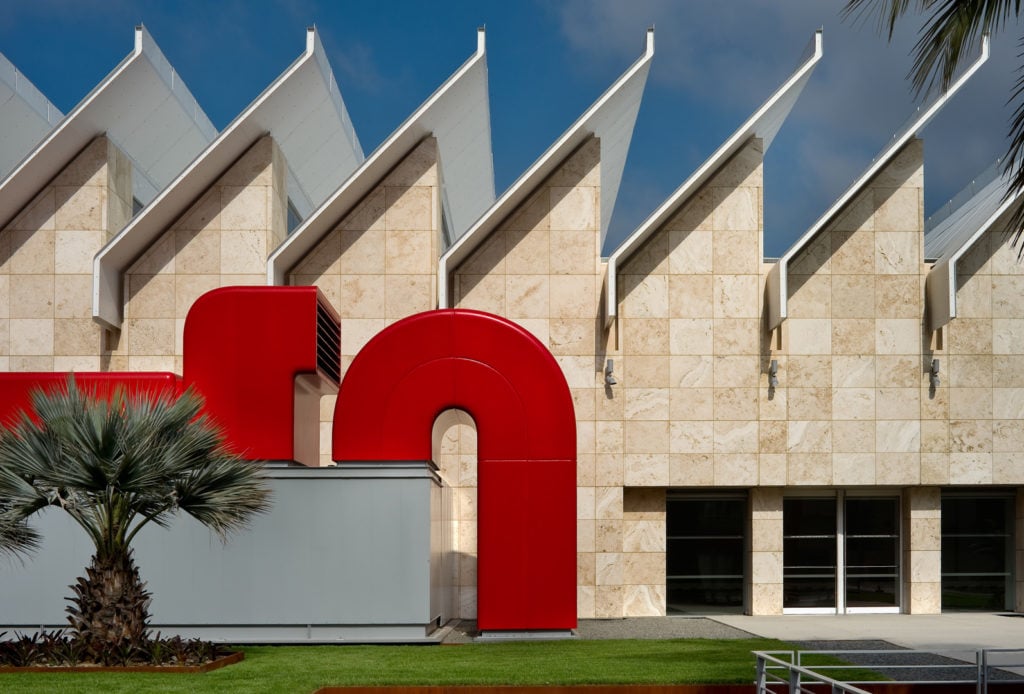Every Monday morning, artnet News brings you The Gray Market. The column decodes important stories from the previous week—and offers unparalleled insight into the inner workings of the art industry in the process.
This week, two reminders that, sometimes, the real business of art is marketing…
BETTING YOUR REPUTATION
On Friday, my colleague Eileen Kinsella relayed the news that the freshly renovated Palms Casino Resort in Las Vegas now offers a 9,000-square-foot, Damien Hirst-designed “sky villa” available at the low, low price of $200,000 per weekend. But as much ire and ridicule as the suite’s existence has already provoked, I think it’s safe to say that, in true Hirst fashion, the main value proposition here is publicity.
But first, a little about the room itself: Included in Hirst’s so-called Empathy Suite (yes, really) are, in Kinsella’s words, “a medicine cabinet filled with diamonds,” “a cantilevered Jacuzzi with mosaic inlaid butterflies and pill decals on the surrounding glass,” and the rotting cherry on top, “a 13-seat curved bar created by Hirst and filled with medical waste.”

The living room of Damien Hirst’s ‘Empathy Suite’ at the Palms Casino. Image courtesy of the Palms Casino Resort, Las Vegas
All of which had me convinced for about an hour that the supposed Palms press release was actually an elaborate troll job. Specifically, it brought back memories of the fake menu for Guy Fieri’s restaurant that went viral a few years back thanks to satirical items like the Panamania!, a “deep-fried snake with a printed-out picture of David Lee Roth stapled on it and a sparkler sticking out of each eye, served with a side of Bud Light you have to wring out of a Hawaiian shirt.” (Side note: I regret to inform you that most, if not all, of the fake menu appears to have been ripped off of other people’s tweets.)
But no, Hirst’s Empathy Suite is real. And this fact leads to the art world’s most common question: Who the hell is going to pay $200,000 to stay there for two nights?
Knowing the business of casino resorts a little bit, I’ll suggest that the answer is “probably almost no one––and the Palms knew that going in.”
For the uninitiated, the most ostentatious suites at casino resorts don’t really get rented out all that often. But that doesn’t mean they don’t get used, and used a lot. Mostly, management comps these mega-suites to VIP gamblers who wager (see: lose) multiples of their per-night cost in the casino itself every stay.
As a reference point, a survey of various online gambling forums reveals that high rollers in Vegas can wager in the range of $150,000 to $400,000 on a single bet, and perhaps more, depending on their verified credit line. Which is why, if you’re a casino resort operator, you hand them the keys to your plushest suite gratis, regardless of what you would charge some rich tourist with no thirst for the high-stakes tables. From a cost-benefit standpoint, it’s a no-brainer.

Damien Hirst, Winner/Loser, 2018, inside his newly designed suite at the Palms Casino Resort. Image courtesy of the Palms Casino Resort, Las Vegas.
On top of this, remember that at the high end, the hospitality industry is in the same business of conspicuous consumption as the elite art market. According to luxury-travel marketplace JetSetter, the two priciest suites in Las Vegas in 2017 went for just(!) $35,000 per night. So by offering a suite with a price tag of $200,000 per minimum two-night stay, the renovated Palms is firing a concussive blast against its foes in the casino resort arms race.
The prospect of staying in what may be the most expensive suite in the world will undoubtedly convince at least one or two plutocrats per year to pay up at the Palms. It’s the same principle that I argued was at work when Saudi crown prince Mohammed bin Salman (through a friend and proxy) paid $450 million for Leonardo da Vinci’s Salvator Mundi: The ultra-wealthy sometimes like to pay as much as possible strictly to show their peers that they can.
In that sense, Hirst and his work are beside the point. It doesn’t much matter which big name designed the “sky villa,” and it definitely doesn’t matter whether the design is in good taste. What matters most is that the Palms decided to charge $200,000 per weekend for it.
So I’d bet that the Empathy Suite spends many, many more nights as a comped room for high-stakes gamblers than a direct paying proposition on its own merits (such as they are). But either way, the project is pure marketing. And if you’re losing your mind over its absurdity, you’re feeding right into Hirst’s hype machine yet again.
[artnet News]

The San Francisco Museum of Modern Art. Courtesy of Wikimedia Commons.
WHAT’S YOUR SIGNAGE?
On Tuesday, Ben Luke penned an op-ed in The Art Newspaper admonishing the San Francisco Museum of Modern Art for becoming the next American institution to play “Flip This Dead White Guy” to fund acquisitions of more institutionally underrepresented artists. The work to be deaccessioned is Mark Rothko’s Untitled (1960). SFMOMA last exhibited it in 2002, and Gary Garrels, the museum’s senior curator of painting and sculpture, called the painting “not of the first rank.” The end result? For the broader good of the collection, it’s been deemed expendable.
Now, you may remember this strategy’s first appearance at the Baltimore Museum of Art (BMA) last year, when pieces by Franz Kline, Robert Rauschenberg, Andy Warhol, and other Caucasians in coffins were deaccessioned to build a “war chest” the museum later pulled from to collect pieces by Carrie Mae Weems, Senga Nengudi, and Meleko Mokgosi, among others. Art-world observers tended to be simultaneously intrigued by and conflicted about the museum’s approach, and the early returns seem similar regarding SFMOMA’s decision to follow Baltimore’s lead.
(For what it’s worth, SFMOMA’s director Neal Benezra distinguished his approach by noting that, unlike the BMA, the California museum will place no strict limits on what can be purchased with proceeds from the sale, although the broader goal is still to diversify the collection.)
Luke makes clear in his piece that he approves of SFMOMA’s mission. It’s the mechanism that troubles him. Of the choice to deaccession Untitled, he writes:
It exposes the skewed priorities of donors and fundraisers that SFMOMA could raise $610m in a capital campaign for its new building, including a massive $245m increase in its endowment, in 2016, and yet in order to fund a vital development of its collection, it sells a work by a major 20th-century artist. Why is supporting bricks and mortar more appealing than lending your name to acquisitions that will transform the museum?
I suspect Luke knows the answer. But since he keeps the question rhetorical, I’ll speak on it: Philanthropy is not always about what the institution actually needs. It’s often about what donors want most. And especially in our new Gilded Age, what donors often want most from their big gifts is maximum name recognition, AKA maximum branding value.
To show how this phenomenon shapes arts philanthropy, let’s play a quick game. How quickly can you think of three specific buildings, wings, or galleries within a larger museum that are named after their primary donors? Personally, it took me about 1.5 seconds to remember the Lynda and Stewart Resnick Pavilion at the Los Angeles County Museum of Art, the Elizabeth A. Sackler Center in the Brooklyn Museum, and the Geffen Contemporary at the Museum of Contemporary Art, Los Angeles. If you go to museums relatively frequently, or even just read about art often, I suspect you had similar results.

The Lynda and Stewart Resnick Pavilion at the Los Angeles County Museum of Art. Photography by James Joel. Image courtesy of Flickr.
Now try to name the specific philanthropists who donated three specific works, or even three specific sets of works, to your favorite museums without some kind of architectural change surrounding them.
I can’t do it. Can you?
Even if you can, I’d bet it was a hell of a lot harder.
The reason is pretty simple: Donate a work, and your name becomes a literal footnote on the accompanying wall text. Donate the money to fund an architectural expansion or renovation, and your name becomes the literal beacon under which everything in that structure happens forevermore. It’s the difference between the institution usurping the donor or the donor usurping the institution. (And obviously, it’s not hard to see how this same phenomenon leads to the 21st-century boom in standalone private museums.)
When it comes to return on investment, then, not all philanthropy is created equal. Which is why none of us should expect SFMOMA to be the last museum to decide it has to deaccession for diversity’s sake.
[The Art Newspaper]
That’s all for this week. ‘Til next time, remember: Sometimes what you do is less important than how you frame it.
Follow Artnet News on Facebook:
Want to stay ahead of the art world? Subscribe to our newsletter to get the breaking news, eye-opening interviews, and incisive critical takes that drive the conversation forward.










